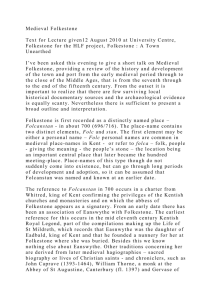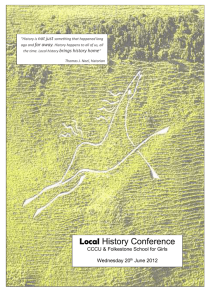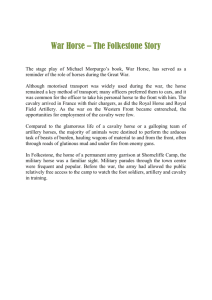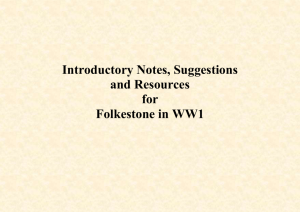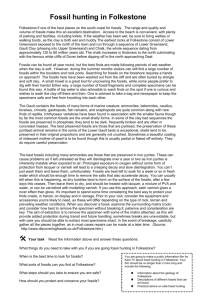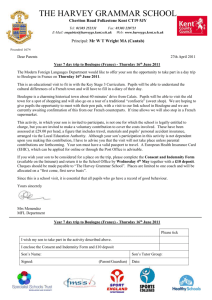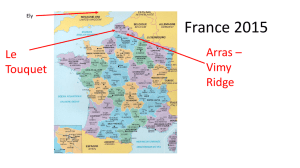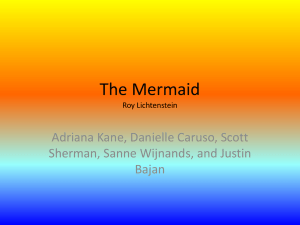Breadth of study - Folkestone Artworks
advertisement
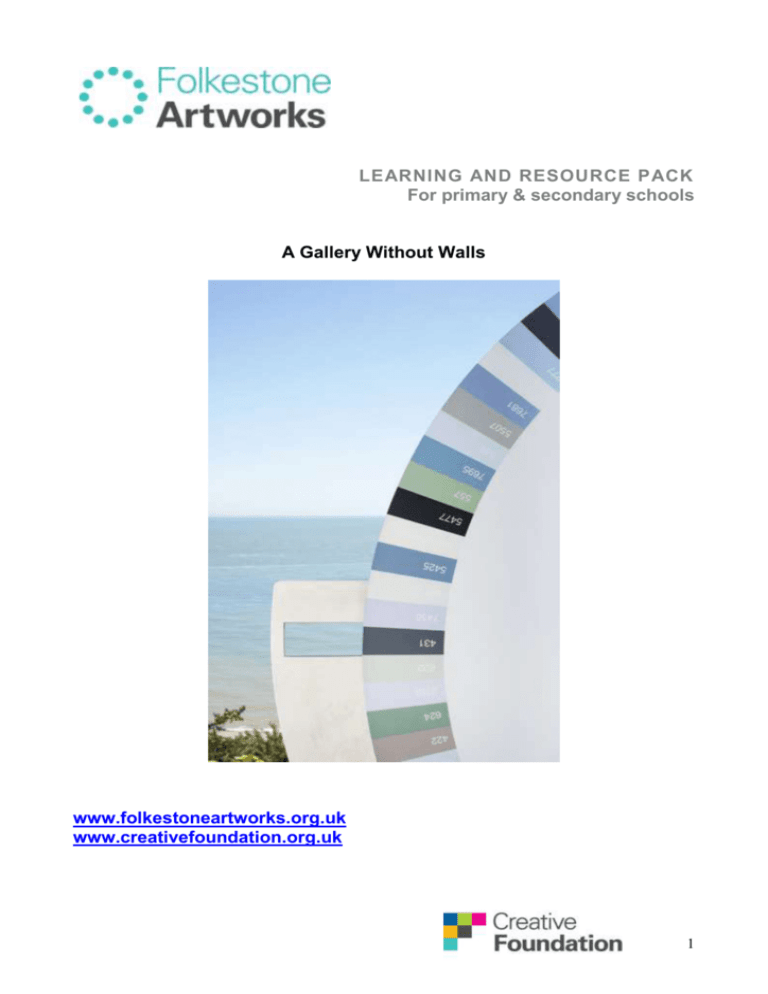
LEARNING AND RESOURCE PACK For primary & secondary schools A Gallery Without Walls www.folkestoneartworks.org.uk www.creativefoundation.org.uk 1 Introduction This pack has been designed to assist primary and secondary school teachers in delivering lessons, to help guide alternative curriculum providers and to initiate ideas for various informal learning opportunities. The pack includes information, ideas, discussions and activities to be carried out whilst out visiting the works as well as back in the classroom. Some activities can be set as holiday projects, encouraging families to explore Folkestone together. The ideas may also interest people working with groups outside of formal education as visiting the collection offers different ways of seeing, thinking and learning about art and the town. Background Folkestone Artworks forms a major component of the arts and education-led regeneration of Folkestone, driven by the Creative Foundation who has developed a burgeoning Creative Quarter populated by artists, independent retailers and creative businesses in a growing number of refurbished studio, living and retail spaces. The Cube Adult Education Centre and Quarterhouse are also located in the Creative Quarter. Folkestone Artworks now consists of 16 high calibre, engaging works commissioned especially for the town and people of Folkestone making the town a unique destination for contemporary art in the UK. The collection includes works by artists as prestigious and well known as Turner Prize nominees Tracey Emin, Richard Wilson, Cornelia Parker and Nathan Coley and 2007 winner Mark Wallinger Experiencing art outside the confines of a gallery or institutional setting breaks down boundaries and encourages a more accessible way for young people to view and think about contemporary art. The inclusive nature of the collection encourages creative questioning, different ways of seeing, learning and thinking about contemporary art; helping to build confidence, communication skills and self-esteem. Key areas being personal, social and emotional development, communication skills, language and literacy, knowledge and understanding of the world as well as critical thinking, physical and creative development. Our learning and events programme nurtures sustainable relationships with often underrepresented audiences, promoting inclusivity and equality. We work with schools, colleges, universities, community groups and arts providers to embed the collection as a learning resource into the curriculum and the cultural fabric of Folkestone and East Kent. To access a map of the artworks, as well as further information on the artists please visit www.folkestoneartworks.org.uk or contact jo.cowdrey@creativefoundation.org.uk 01303 245799 Archive films are also available to view on request. Works Included Tonico Lemos Auad ‘Carrancas’ 2011 (Boat figureheads and brick fist, Folkestone Harbour) Ruth Ewan ‘We Could Have Been Anything That We Wanted To Be’ 2011 (Clock with the time altered to French Revolutionary time, Top of the Zig Zag Path, The Leas) Cornelia Parker ‘The Folkestone Mermaid’ 2011 (Bronze life cast figure on granite boulder, Sunny Sands) Patrick Tuttofuoco ‘Folkestone’ 2008 (Folkestone sign on harbour arm pier) 2 TONICO LEMOS AUAD Born: 1968 Belem, Brazil Lives/Works: London Title ‘Carrancas’ Location Folkestone Harbour Introduction Tonico Lemos Auad has made a series of Carrancas boat figureheads, more usually found on riverboats in northeast Brazil and used as symbolic talismans to protect sailors. Carrancas are zoo anthropomorphic figures that frequently mix the features of humans, horses and lions and are used as talismans to protect the local fishermen from evil spirits, an expression of the universal desire for something magical, something larger than ourselves to help us conquer our trepidations. Looking closely some features on these curios structures soon become apparent, there are heads, human forms, some gargoyles eyes and a large brick fist that lies heavy on the seabed, and as the height of the objects attached to the posts vary, these forms will appear and disappear with the rise and fall of the tide. Erosion and mutability are important qualities in Tonico Lemos Auad’s sculptural works and in Folkestone he was inspired by the weathered stone sculptures on the nearby parish church of St Mary and St Eanswyths. Auad was born and raised in Belem, Northern Brazil, which like Folkestone is a port town. There he was fascinated by the ritualistic processions for an afro- Brazilian goddess of the sea. In these celebrations a votive object symbolizing the wishes of the carrier, a brick for instance could represent a whole house, was transported through the streets down to the beach. Images of these festivals along with Folkestone’s own annual blessings of the fisheries, the multi-cultural charivari day procession were inspirations for the artist. Above: Images by Tonico Lemos Auad 3 Primary Key Stages 1 and 2 Art and Design Focus Key Stage 1 Art and Design Key Stage 2 Investigating and making art, craft and design Try out tools and techniques and apply these to materials and processes, including drawing. Represent observations, ideas and feelings, and design and make images and artefacts. Breadth of study Investigating different kinds of art craft and design [for example, in the locality, in original and reproduction form, during visits to museums, galleries and sites, on the internet]. Focus Investigating and making art, craft and design Apply their experience of materials and processes, including drawing, developing their control of tools and techniques. Use a variety of methods and approaches to communicate observations, ideas and feelings, and to design and make images and artefacts. Breadth of study Investigating art, craft and design in the locality and in a variety of genres, styles and traditions [for example, in original and reproduction form, during visits to museums, galleries and sites, on the internet]. National Curriculum 2b 2c 5d National Curriculum 2b 2c 5d Activity Art and Design: Make a mask for decoration that mixes human features with those of an animal. Think about how masks are used to create certain atmospheres and portray events. Images by Tonico Lemos Auad 4 Secondary Key Stages 3 and 4 Art and Design Focus Key Stage 3 Art and Design Key Stage 4 Investigating and making art, craft and design Apply and extend their experience of a range of materials and processes, including drawing, developing refining their control of tools and techniques. Experiment with and select methods and approaches synthesise observations, ideas and feelings, and to design and make images and artefacts. Breadth of study Investigating art, craft and design in the locality, in a variety of genres, styles and traditions, and from a range of historical, social and cultural contexts [for example, in original and reproduction form, during visits to museums, galleries and sites, on the internet]. Focus National Curriculum 2b 2c 5d National Curriculum How ideas, feelings and meanings are conveyed and interpreted in images, artefacts, products and other media How images, artefacts and products relate to social, historical, vocational and cultural contexts Activity A Myth is a bit like a legend or a folktale – a traditional typically ancient story with supernatural beings, ancestors or heroes that touches on cultural practices. A collection of myths or a study of them is called mythology. In mythology a hybrid is a creature combining body parts of two or more species. Art and Design: Make a mask for decoration that mixes human features with those of an animal. Discuss the use of masks in different cultures and ceremonies. Think about how masks are used to create certain atmospheres and portray/convey events. Research historical and contextual references of mask collections from different cultures and countries; look at their colours, techniques and uses. Or alternatively research talismans and create your own personal talisman. There is a suggested booklist for Cultural Mask research at: http://www.readwritethink.org/classroom-resources/lesson-plans/behind-masks-exploring-culture395.html?tab=3 With some Cultural Mask resources and web-links at: http://storytrail.com/masks/resources.htm 5 RUTH EWAN Born: 1980 Aberdeen, Lives/Works: London Title ‘We Could Have Been Anything That We Wanted To Be’ Location Top of the Zig Zag Path, The Leas, Folkestone, CT20 2EF Introduction This clock has been subtly altered to tell French revolutionary time on one clock face and actual time on the other. Ruth Ewan is interested in social models of protest and propaganda. This particular work is based on when, in 1793, the Gregorian calendar was abandoned in favour of an entirely new model, The French Republican Calendar, which became the official calendar of France for 13 years. Decimalisation of time was also adopted. Each day in the Republican Calendar was made up of 10 decimal hours, with each decimal hour divided into 100 decimal minutes and each decimal minute into 100 decimal seconds. Ruth Ewan also produced a booklet bringing decimalised time into context, whilst narrating the violent and ideological history of a seemingly benign object – a public clock. These are available on request from jo.cowdrey@creativefoundation.org.uk A decimal wall clock Republican Calendar. Images: Ruth Ewan 6 Primary Key Stages 2 English Focus Key Stage 2 En3 Writing Breadth of study To imagine and explore feelings and ideas, focusing on creative uses of language and how to interest the reader National Curriculum 9a Activity Clocks and Time The history of clocks is very long, and there have been many different types of clocks over the centuries. The first way that people could tell the time was by looking at the sun as it crossed the sky. The oldest type of clock is a sundial clock first used around 3,500 B.C. (about 5,500 years ago). Sundials use the sun to tell the time. The shadow of the sun points to a number on a circular disk that shows you the time. What do you think the main problem with telling the time with a sundial clock was? Around 1400 B.C. (about 3,400 years ago), water clocks were invented in Egypt these were much more accurate than sundials. Later it was decided to divide the year into months and days. Later still into hours, minutes and seconds. In 1884 time zones were introduced. Imagine a world without the invention of measuring time? Write a story about what type of experiences and problems you would encounter in your day-today life and what other things would be affected if there weren’t any clocks. For more information on time visit: http://www.absoluteastronomy.com/topics/Time 7 Secondary Key Stages 3 and 4 Citizenship Focus Key Stage 3 Art and Design Key Stage 3 Art and Design Key Stage 4 Developing skills of enquiry and communication Think about topical political, spiritual, moral, social and cultural issues, problems and events by analysing information and its sources, including ICT-based sources Contribute to group and exploratory class discussions, and take part in debates. Focus Exploring and developing ideas Record and analyse first-hand observations, to select from experience and imagination and to explore ideas for different purposes and audiences Focus National Curriculum 2a 2c National Curriculum 1a National Curriculum How the knowledge and understanding of the work of others can develop and extend thinking, and inform their own work How images, artefacts and products relate to social, historical, vocational and cultural contexts Activity Protest Citizenship/Art and Design: You may have watched the elections on the television or seen people publicly protesting and have an insight into different people’s opinions on the way things should be done. You are to organise a protest – what are you protesting against and why? Discuss your ideas with your class. Create a banner that gets your message across. Look at historical and contextual references of protest within different cultures and countries in particular the French Revolution. More information on the French Revolution can be found here: http://en.wikipedia.org/wiki/French_Revolution To find out more about protest visit: http://www.absoluteastronomy.com/topics/Protest and http://en.wikipedia.org/wiki/Protest 8 CORNELIA PARKER Born: 1956 UK Lives/Works: London Title The Folkestone Mermaid Location At the end of The Stade over looking Sunny Sands Introduction Cornelia Parker’s sculpture of a local Folkestone woman is life-sized and is cast in bronze. It is based on Copenhagen’s Little Mermaid, which was inspired by the Hans Christian Anderson fairy story. The ‘Folkestone Mermaid’ gazes enigmatically out to sea perhaps anxious about our futures. Because the cast is of a real life person she is worldlier and more, well-endowed than the nymphlike original. All women of Folkestone were offered the opportunity to model for the mermaid. Through a process of open submission, Parker chose Georgina Baker, mother of two and Folkestone born and bred. Unlike the idealised Copenhagen version, this is a life-size, life-cast sculpture, celebrating the local and the everyday. Parker’s mermaid, a more confident and knowing lady of the sea than Hans Christian Andersen’s fairytale one, is a permanent work for Folkestone. Parker has become known for her installations and interventions, including ‘Cold Dark Matter: An Exploded View’ (1991), where she suspended the fragments of a garden shed, blown up for her by the British Army; and ‘The Maybe’, a collaboration with actress Tilda Swinton, at the Serpentine Gallery in 1995. She wrapped Rodin’s ‘The Kiss’ with a mile of a string to make a new work ‘The Distance (a kiss with string attached)’ for her contribution to the Tate Triennial (2003). Above: Georgina Baker, the model for ‘The Mermaid’ with the life cast. 9 Primary Key Stages 1 and 2 English Focus Key Stage 1 En1 En2 En3 Listening Sustain concentration Remember specific points that interest them Make relevant comments Listen to others’ reactions Ask questions to clarify their understanding Identify and respond to sound patterns in language [for example, alliteration, rhyme, word play]. Speaking Telling stories real and imagined Literature Retellings of traditional folk and fairy stories Writing Breadth of study To create imaginary worlds Art and Design Focus Key Stage 1 Exploring and Developing Ideas Record from first-hand observation, experience and imagination, and explore ideas English Focus Key Stage 2 En1 Listening Breadth of study Live talks/readings/presentations Writing Breadth of study To imagine and explore feelings and ideas, focusing on creative uses of language and how to interest the reader En3 National Curriculum 2a 2b 2c 2d 2e 2f 8a 6c 9b National Curriculum 1a National Curriculum 9a 9a Activity Underwater - Story Telling and Creative Writing At the beginning work with the entire class and introduce the story of ‘The Little Mermaid’ and explain that it is set underwater in the ocean. Ask the class to think of as many things that they might find underwater and write any suggestions either on the board or on flipchart. Try to encourage pupils to suggest unusual items, which may have been lost in the ocean or have ended up in the water by accident (such as shoes, rubbish etc). Have each pupil choose one item and create a short story of how his or her item came to be underwater. This should be both written work and pictures. Once time has been given for this, have the group form small groups of about three or four. Have each group select one of their object stories to have as their group story. Using the selected story, ask each group to create three still images, which will tell 1: The beginning, 2: The middle and 3: The end of the story. Allow each group to present their images and have the rest of the class suggest ideas as to what they think the story is about. Read the story of The Little Mermaid here: http://www.surlalunefairytales.com/littlemermaid/index.htmll Find out more about Hans Christian Andersen and the story of The Little Mermaid at: http://www.absoluteastronomy.com/topics/The_Little_Mermaid 10 Secondary Key Stages 3 and 4 Art and Focus Design Key Stage 3 Breadth of Study Exploring a range of starting points for practical work including themselves, their experiences and natural and made objects and environments. Working on their own, and collaborating with others, on projects in two and three dimensions and on different scales Using a range of materials and processes, including ICT [for example, painting, collage, print making, digital media, textiles, sculpture. Investigating art, craft and design in the locality, in a variety of genres, styles and traditions, and from a range of historical, social and cultural contexts [for example, in original and reproduction form, during visits to museums, galleries and sites, on the internet]. Art and Design Key Stage 4 Focus National Curriculum 5a 5b 5c 5d National Curriculum How ideas, feelings and meanings are conveyed and interpreted in images, artefacts, products and other media How the knowledge and understanding of the work of others can develop and extend thinking, and inform their own work Activity Monuments Art and Design: Create a monument for a famous person. Discuss the word monument. Name and discuss famous monuments in the UK and abroad. Imagine you are an artist who has been asked to design a monument for a famous person. Which person would you choose to honour with a monument? Why? What kind of image and design would you create for your monument? Write a short paragraph explaining the reason you chose the particular famous person; describe the design of the monument and where it would be situated. Create designs and make a model. Present to the group and evaluate. (Includes: English and History opportunities for cross-curricular links). More information on the Little Mermaid Statue in Copenhagen can be found at: http://www.absoluteastronomy.com/topics/The_Little_Mermaid_(statue) 11 Secondary Key Stages 3 and 4 Citizenship Focus Key Stage 3 Developing skills of enquiry and communication Think about topical political, spiritual, moral, social and cultural issues, problems and events by analysing information and its sources, including ICT-based sources Contribute to group and exploratory class discussions, and take part in debates Citizenship Focus Key Stage 4 Developing skills of enquiry and communication Research a topical political, spiritual, moral, social or cultural issue, problem or event by analysing information from different sources, including ICT Contribute to group and exploratory class discussions, and take part in formal debates. National Curriculum 2a 2c National Curriculum 2a 2c Activity Beauty Citizenship: Look carefully at Cornelia Parker’s sculpture. Think about women and men you see in magazines, on television and in films. What do you think is the western society ideal of beauty? Look at historical and contextual references such as: Ruben’s female forms, Pre-Raphaelites, the historical practice of binding feet in China, Size Zero – in the past what were other ideals of beauty? What do you think the artist was trying to portray when she based her sculpture on a member of the Folkestone community? 12 PATRICK TUTTOFUOCO Born: 1974 Italy Lives/Works: Milan Italy Title Folkestone Location Harbour arm pier, visible from Sunny Sands Introduction The Orient-Express, most glamorous of trains and epitome of stylish international travel used to pull in weekly at Folkestone Harbour Railway Station. Tuttofuoco and two of his collaborators reenacted the classic journey from Istanbul to Paris and Folkestone. FOLKESTONE, his large sculpture on the harbour arm, is the result of this journey. The individual ‘letters’ were chanced upon by the artist through social situations and incidents with people along the route. FOLKESTONE sculpture suggested viewing points: The East Cliff or Sunny Sands. Patrick Tuttofuoco is interested in how people interact with each other, groups they form and the behaviors they follow, the towns and cities they design and live in. Journey of different types and lengths are therefore a rich source of inspiration for him. They open up the possibility of new encounters and experiences, both on a broad cultural level and on a more intimate, personal level. Tuttofuoco and his travel companions, an architect and a filmmaker, followed the route of the train from Istanbul back to Folkestone, almost as an act of pilgrimage. As a way of marking their trail, they collected a letter from each of the countries they passed through, which together would form the name Folkestone. Actively seeking ways of working with people along the way, each letter is the result of a unique meeting or collaboration, a symbol that stands for that leg of their odyssey. A film of the journey is available in the archive; please contact jo.cowdrey@creativefoundation.org.uk if you wish to view this. 13 Primary Key Stages 1 and 2 English Key Stage 1 En 1 Key Stage 1 En 2 Citizenship Key Stage 2 Focus Speaking and Listening Group words with precision Telling stories, real and imaginary Reading strategies Understand how word order affects meaning Work out the sense of a sentence by re-reading Focus Developing Good Relationships Talk to other people, play and work cooperatively Breadth of Opportunities Develop relationships through work and play National Curriculum 1b 8a 1i 1k National Curriculum 4b 5f Activity Using Patrick Tuttofuoco’s work as a starting point, ask the students to collect souvenirs or objects from home, holidays and visits to other places. Consider how the objects within the collection have different places of origin, perhaps these origins could be plotted on a map. Each student will have a particular relationship with their chosen object. Encourage them to create a short story based on their object and its relationship to the collection as a whole. Create a map to track the route of the objects from origin to the classroom/work room. 14 Secondary Key Stages 3 and 4 Geography Key Stage 3 Art and Design Key Stage 4 Focus Knowledge and understanding of places Describe and explain the physical and human features that give rise to the distinctive character of places Focus National Curriculum 3c National Curriculum How ideas, feelings and meanings are conveyed in images, artefacts and other media Activity The ten letters of Patrick Tuttofuoco’s F,O,L,K,E,S,T,O,N,E are each inspired by the things he and his collaborators saw or people that they met on their journey through the ten countries on the route of the Orient Express. Behind each letter is a story, these stories are told in the film the artist made on his journey. The shape of the letter K, for example evolved from the silhouette of a stunt biker they saw performing in a square in Bulgaria. Think of a journey they might take, perhaps from their home to the nearest town centre. Create your own letterforms based on the people and places you meet and pass on your journey. Combine the letters in a word that describes your journey. When presenting your word elaborate on the story behind each letter and see if your classmates can recognise the real-world forms you have used to create them. We look forward to seeing any work created by your pupils and we would love to hear about your visit to the artworks! For more information about the artworks, tours and arranging a visit please contact: Jo Cowdrey, Folkestone Artworks Curator jo.cowdrey@creativefoundation.org.uk 01303 245799 The Creative Foundation The Block 65 – 69 Tontine Street Folkestone Kent CT20 1JR 15
